Hollywood Regency style captures the glamour of 1940s and 1950s movie star homes. Crystal chandeliers sparkle overhead.
Mirrors reflect light across walls. Velvet sofas sit beside leopard-print chairs. This interior design style combines bold colors, shiny surfaces, and luxurious furniture to create spaces that feel like million-dollar mansions.
The surprising part is that Hollywood Regency rooms are not just for show. They balance drama with comfort, making them livable and enjoyable for everyday use.
Let’s go through what defines Hollywood Regency, its history, and practical ways to bring this classic glamour into your own home.
What Is Hollywood Regency Style?
Hollywood Regency is an interior design style that mixes luxury with comfort. Think of it as decorating like a movie star from the golden age of Hollywood.
The style has signature looks that make it easy to spot. High-contrast colors are a big deal, like black and white together or rich jewel tones such as emerald green and sapphire blue.
Shiny, reflective surfaces show up everywhere: mirrors on furniture, lacquered finishes that gleam like glass, and metals like chrome and brass.
Plush textiles add softness to all that shines. Velvet couches, silk curtains, and satin pillows make rooms feel cozy.
A Short History of Hollywood Regency Interior Design
Hollywood Regency originated in Southern California from the 1920s through the 1950s. Movie stars wanted homes that matched their glamorous personas, creating showcases of wealth and taste.
Two designers defined the style: Dorothy Draper popularized bold color combinations, oversized botanical prints, and thick stripes.
William “Billy” Haines, a former actor turned decorator, created rooms with lacquered furniture and mirrored surfaces that balanced glamour with comfort.
The style faded for decades but returned in the late 1990s and 2000s. Designers like Kelly Wearstler revived the high-gloss glamour and maximalism for modern homes.
Key Characteristics of Hollywood Regency
What makes Hollywood Regency different from other design styles? Several signature elements work together to create that unmistakable look.
1. Contrast & Color
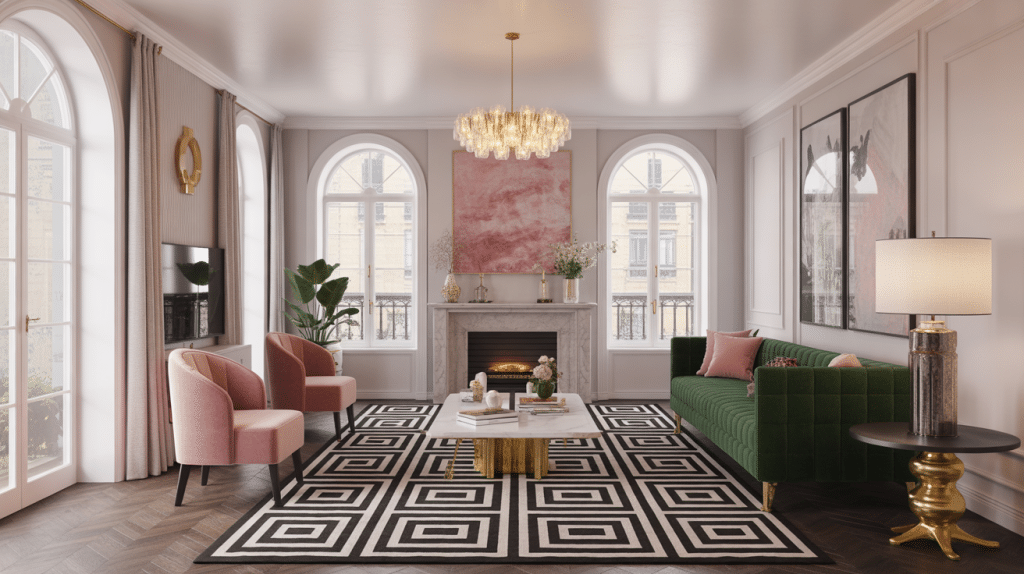
Hollywood Regency thrives on dramatic color combinations. Black and white pairings create sharp visual impact, while rich jewel tones like ruby red, emerald green, and sapphire blue add depth.
Saturated pastels such as bright pink and vivid turquoise provide unexpected energy. The goal is high contrast, where colors amplify each other rather than blend together.
2. Shine & Reflection
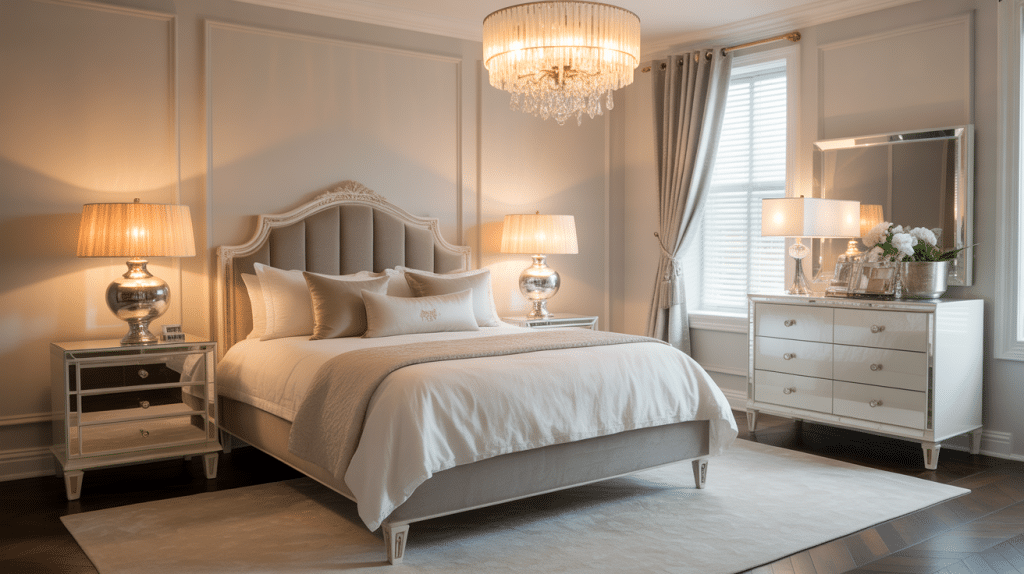
Reflective surfaces define this style. Mirror-clad furniture like nightstands with mirror panels or console tables covered in mirrored tiles bounce light throughout rooms.
Chrome and brass add a metallic gleam to fixtures and hardware. Lacquer finishes on tables, cabinets, and doors create a glossy, almost wet appearance.
Crystal chandeliers complete the shimmering effect.
3. Patterns & Motifs
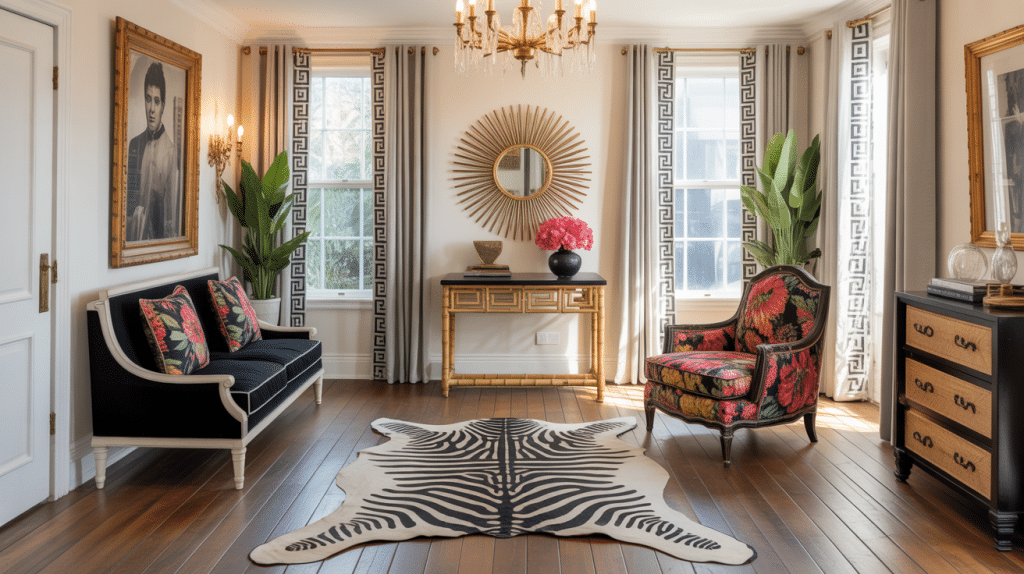
Bold patterns create visual excitement. Animal prints, especially leopard and zebra, inject wild energy. Greek key designs (maze-like geometric patterns) appear on pillows, rugs, and borders. Sunburst mirrors with rays extending outward serve as iconic symbols.
Faux bamboo furniture, bold florals, and zig-zag patterns add layers of interest without overwhelming spaces.
4. Texture & Luxe Materials
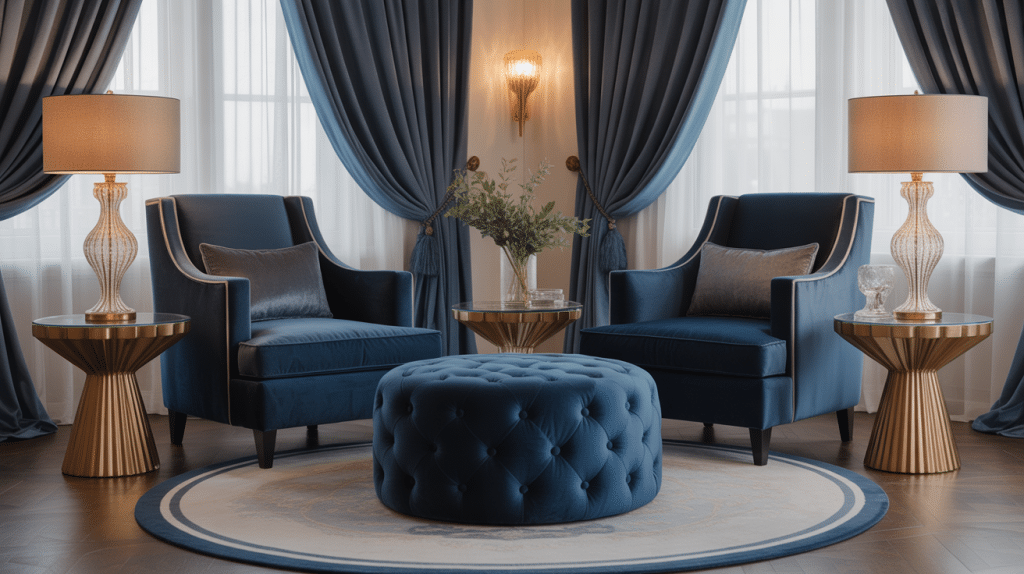
Luxury fabrics balance the hard shine of metals and mirrors. Velvet, with its deep, soft pile, covers sofas and chairs. Satin and silk bring smoothness to window treatments and pillows. Mohair adds fuzzy warmth.
Tufting (button details on upholstery) and channeling (parallel stitching lines) give furniture a tailored, sophisticated appearance.
5. Statement Pieces
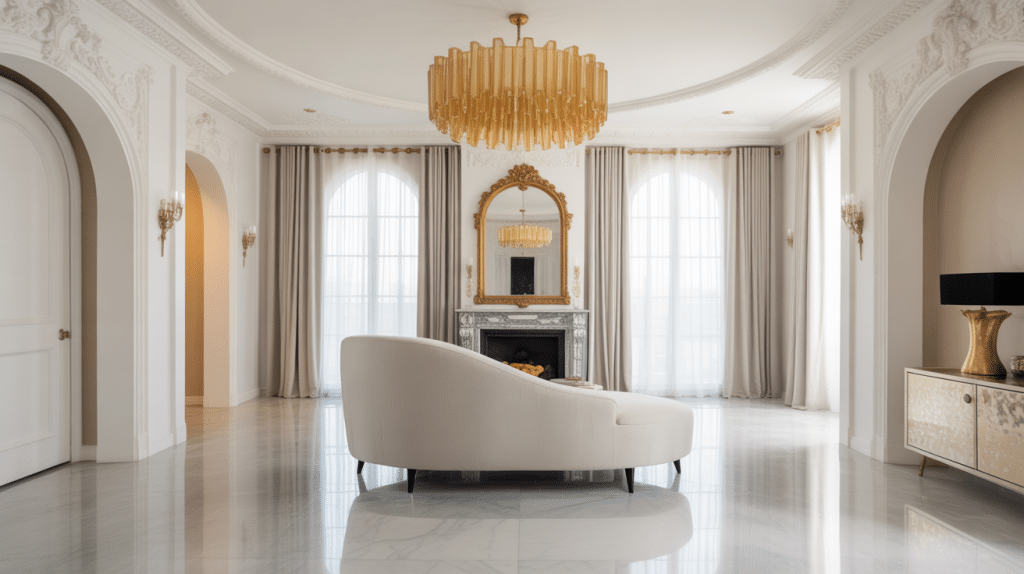
Hollywood Regency rooms feature carefully chosen focal points rather than cluttered spaces. Sculptural lighting fixtures function as modern art.
Oversized mirrors with ornate frames become room centerpieces. Curvy divans and chaise longues add romantic elegance.
Each piece is edited and theatrical, designed to command attention and create maximum visual impact.
How to Decorate with Hollywood Regency
Ready to bring Hollywood glamour into your home? These practical tips will help you achieve the look without overwhelming your space.
- Start with a neutral base. Use white walls or a black-and-white area rug as your foundation, then layer in bold colors and patterns so they really stand out.
- Add a statement mirror. Choose a sunburst mirror or an oversized ornate mirror to instantly create that glamorous, light-reflecting effect Hollywood Regency is known for.
- Incorporate metallic accents. Mix brass and chrome through lighting fixtures, hardware, and furniture legs to add shine without going overboard.
- Choose one luxe textile. Pick velvet for your sofa, silk for curtains, or satin for pillows to bring softness and comfort to balance all the hard, shiny surfaces.
- Limit animal prints to one piece. A single leopard-print ottoman or zebra-print pillow adds wild energy; more than that can make the room feel chaotic.
- Create symmetry somewhere. Place matching lamps on either side of a sofa or identical nightstands flanking a bed to achieve that polished, hotel-suite look.
With these guidelines, you can capture Hollywood Regency’s dramatic glamour while keeping your space livable and balanced.
Hollywood Regency vs. Art Deco: What’s the Difference?
People often confuse Hollywood Regency with Art Deco because they’re from similar time periods and both embrace luxury. However, they have distinct personalities and design approaches.
| Aspect | Hollywood Regency | Art Deco |
|---|---|---|
| Time Period | 1920s-1950s, revived in 1990s-2000s | 1920s-1940s |
| Overall Attitude | Eclectic, playful, theatrical, breaks rules deliberately | Geometric, streamlined, disciplined, follows strict rules |
| Shape & Form | Embraces curves, organic shapes, and faux bamboo with irregular texture | Strict geometry, perfect symmetry, clean lines, angular zigzags |
| Pattern Choices | Animal prints (leopard, zebra), bold florals, cheeky excess, Greek keys | Precise zigzags, sunbursts, chevrons, streamlined repetition |
| Color Approach | High contrast black-white, saturated jewel tones, bold pastels | Metallic tones, black and gold, muted, sophisticated palettes |
| Materials | Mirror-clad furniture, lacquer, velvet, satin, chrome, brass | Polished metals, glass, exotic woods, chrome, and geometric inlays |
| Room Feel | Glamorous movie set with humor, comfortable luxury, and livable drama | Polished ocean-liner or skyscraper lobby, serious sophistication |
| Key Mood | Fun, theatrical, inviting you to relax and enjoy | Refined, precise, asking you to admire its perfection |
Hollywood Regency Interior Design: Top Designers & Their Ideas
Several talented designers created and defined Hollywood Regency. Their individual styles help us understand the range within this glamorous look.
1. Dorothy Draper
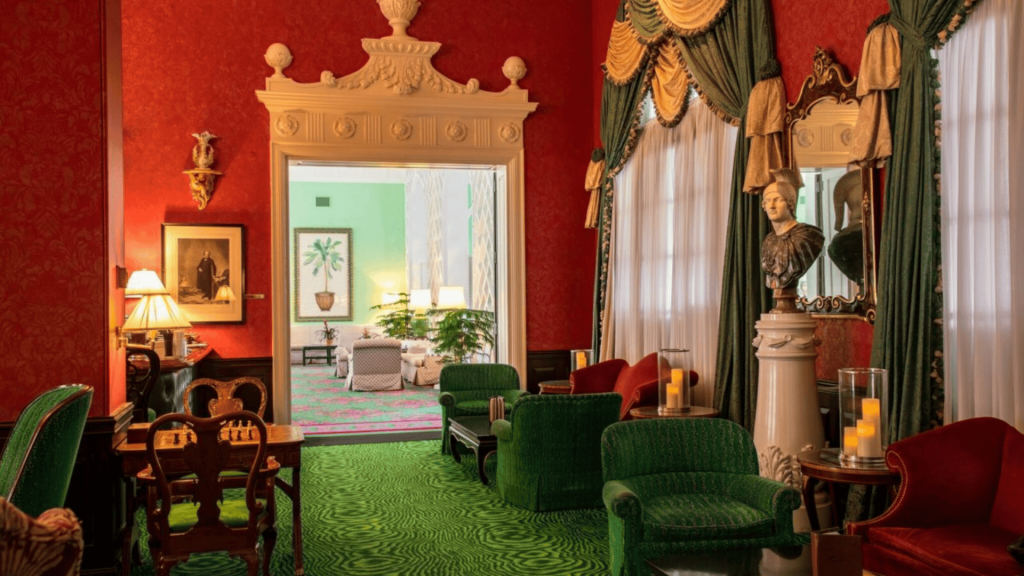
Dorothy Draper was fearless with color. She’d take a white-and-black base and add saturated bright colors that most people would be scared to use.
Her most famous project was The Greenbrier resort in West Virginia, where she created hotel-level drama that still wows visitors today.
Try this: Paint your interior doors in glossy lacquer. Add bold patterned wallpaper to one accent wall. Don’t be timid with scale; bigger is better in Draper’s world.
2. William “Billy” Haines

Billy Haines decorated homes for Hollywood’s biggest stars, including Joan Crawford and Carole Lombard. He understood that movie stars wanted glamour, but they also actually lived in these houses.
His solution? Comfortable silhouettes in luxurious finishes. His furniture had tailored, clean lines but was covered in sumptuous fabrics and paired with brass and mirror accents.
Try this: Choose low, loungey seating, sofas, and chairs you can really sink into. Add brass hardware and mirrored accessories to elevate simple furniture.
3. Kelly Wearstler (The Revival)
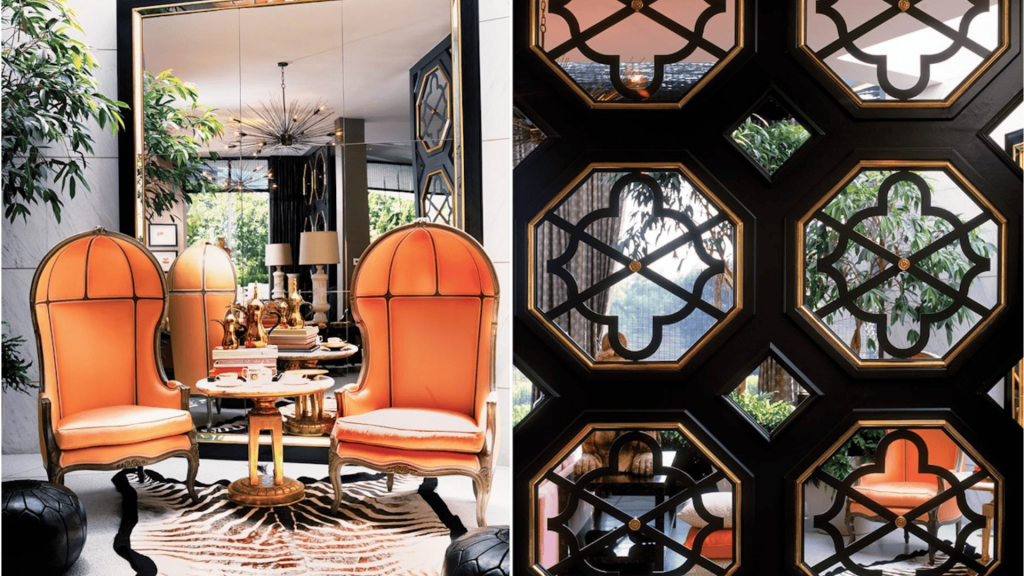
Kelly Wearstler brought Hollywood Regency back to life in the 21st century with her contemporary maximalist approach. She mixes marble and metals, uses graphic bold patterns, and isn’t afraid of dramatic scale.
Her work shows that the Hollywood Regency attitude works perfectly in modern spaces: you don’t need a vintage house to pull it off.
Try this: Mix different types of stone in one room: marble, agate, malachite. Choose sculptural lighting that’s more art than a light fixture. Go bigger and bolder than you think you should.
Conclusion
Hollywood Regency brings old Hollywood glamour into modern homes through high-contrast colors, reflective surfaces, plush textiles, bold patterns, and statement pieces.
This style balances drama with comfort, making spaces feel luxurious yet livable.
Drawing inspiration from Dorothy Draper’s fearless color, Tony Duquette’s theatrical fantasy, or Kelly Wearstler’s contemporary maximalism, there’s always room for personal interpretation.
Start small with a mirrored side table or leopard-print pillow, or go bold with a full room makeover. The goal is simple: create a space that makes you feel like a star every time you walk through the door.
Which Hollywood Regency element will you try first? Share your decorating plans in the comments below!


